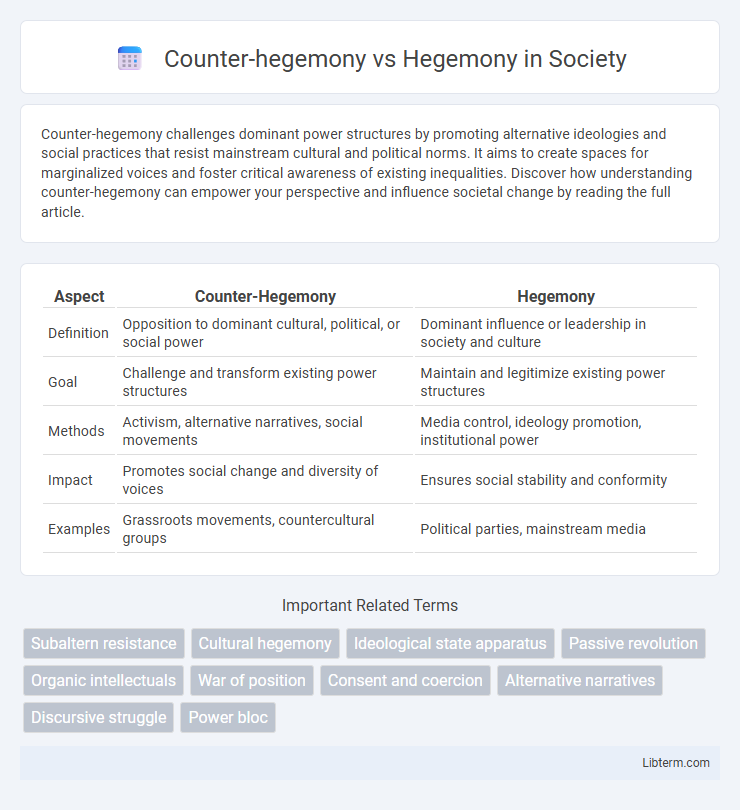Counter-hegemony challenges dominant power structures by promoting alternative ideologies and social practices that resist mainstream cultural and political norms. It aims to create spaces for marginalized voices and foster critical awareness of existing inequalities. Discover how understanding counter-hegemony can empower your perspective and influence societal change by reading the full article.
Table of Comparison
| Aspect | Counter-Hegemony | Hegemony |
|---|---|---|
| Definition | Opposition to dominant cultural, political, or social power | Dominant influence or leadership in society and culture |
| Goal | Challenge and transform existing power structures | Maintain and legitimize existing power structures |
| Methods | Activism, alternative narratives, social movements | Media control, ideology promotion, institutional power |
| Impact | Promotes social change and diversity of voices | Ensures social stability and conformity |
| Examples | Grassroots movements, countercultural groups | Political parties, mainstream media |
Understanding Hegemony: Definition and Historical Context
Hegemony refers to the dominance of one social group or nation over others, established through cultural, ideological, and political means rather than mere force. Historically, Antonio Gramsci's concept of hegemony highlights how ruling classes maintain power by securing the consent of subordinate groups via cultural institutions and social norms. Counter-hegemony emerges as resistance against this dominance, challenging prevailing ideologies to create alternative social and political structures.
What is Counter-Hegemony? Key Concepts Explained
Counter-hegemony refers to a resistance movement that challenges the dominant cultural, political, and economic power structures imposed by hegemony. Key concepts include the idea of contesting and disrupting the ruling ideology through alternative narratives, grassroots activism, and subversive practices that empower marginalized groups. Counter-hegemonic strategies aim to create social change by exposing inequalities and promoting diverse, inclusive perspectives against established dominance.
Theoretical Foundations: Gramsci and Beyond
Counter-hegemony challenges dominant power structures by promoting alternative cultural and ideological frameworks, rooted in Antonio Gramsci's theory of cultural hegemony. Gramsci emphasized the role of civil society in maintaining hegemonic consent, highlighting the importance of intellectuals and cultural institutions in shaping power dynamics. Beyond Gramsci, theorists expand counter-hegemony to contemporary social movements, focusing on grassroots resistance and the creation of subaltern narratives that disrupt dominant ideology.
Mechanisms of Hegemonic Control in Society
Hegemony operates through mechanisms such as cultural institutions, media narratives, and educational systems that normalize dominant ideologies and maintain social order by securing consent rather than force. Counter-hegemony challenges this dominance by creating alternative discourses and practices that expose and resist the naturalization of hegemonic power. Both processes involve struggle over meaning and authority within civil society, where hegemonic control is continuously contested and negotiated.
Strategies and Tools of Counter-Hegemonic Movements
Counter-hegemonic movements employ grassroots organizing, alternative media, and cultural resistance to undermine dominant power structures embedded in hegemonic ideologies. These strategies often include building alliances across marginalized groups, promoting counter-narratives through social platforms, and mobilizing civil disobedience to challenge institutional norms. Tools such as community education, participatory decision-making, and international solidarity networks increase the visibility and legitimacy of counter-hegemonic agendas against hegemonic dominance.
Case Studies: Counter-Hegemony in Politics and Culture
Counter-hegemony in politics and culture challenges dominant power structures by promoting alternative ideologies and social practices that resist mainstream narratives. Case studies such as the Civil Rights Movement in the United States and the feminist wave in Latin America highlight how grassroots activism and cultural production effectively contest hegemonic norms. These movements use strategies like protest, art, and media to create spaces for marginalized voices, thereby disrupting established hegemonic control and fostering social transformation.
The Role of Media in Shaping Hegemony and Counter-Hegemony
Media serves as a critical tool in establishing and maintaining hegemony by promoting dominant cultural narratives and legitimizing power structures through selective representation and framing. Counter-hegemony utilizes alternative media platforms and social networks to challenge prevailing ideologies, mobilize marginalized groups, and disseminate oppositional discourses that contest dominant paradigms. The dynamic interplay between hegemonic and counter-hegemonic media shapes public consciousness, influencing social norms and political power relations within society.
Counter-Hegemony in the Digital Age: Opportunities and Challenges
Counter-hegemony in the digital age leverages social media platforms and decentralized networks to challenge dominant power structures by amplifying marginalized voices and facilitating grassroots mobilization. Digital tools create opportunities for rapid information dissemination, enabling counter-hegemonic movements to contest hegemonic narratives and influence public discourse at unprecedented scales. However, challenges include algorithmic censorship, digital surveillance, and misinformation campaigns that hinder effective resistance and complicate the maintenance of authentic counter-hegemonic spaces.
Impacts and Outcomes: Evaluating Successes and Failures
Counter-hegemony challenges dominant power structures by promoting alternative ideologies that seek social justice, often resulting in increased political awareness and grassroots mobilization. Hegemony maintains established control by shaping cultural and political norms, securing stability but sometimes perpetuating inequality and resistance. Evaluating successes reveals that counter-hegemonic movements can disrupt status quo and inspire reform, while hegemonic systems often sustain economic growth and social order despite facing ongoing opposition.
Future Perspectives: The Evolving Battle Between Hegemony and Counter-Hegemony
The evolving battle between hegemony and counter-hegemony increasingly shapes global power dynamics as emerging movements challenge established dominant ideologies through digital activism and grassroots mobilization. Future perspectives suggest a more fragmented international order where counter-hegemonic forces leverage technology and transnational networks to contest and reshape cultural, economic, and political hegemonies. This ongoing contestation signals a shift towards multipolarity, with competing narratives driving systemic change in governance and societal norms.
Counter-hegemony Infographic

 libterm.com
libterm.com